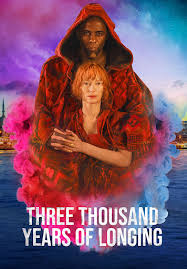
👉Download full Movie here 👈
The story revolves around two central characters: Alithea Binnie, played by Tilda Swinton, and the Djinn, portrayed by Idris Elba. Alithea is a solitary, middle-aged scholar who specializes in narratology, studying myths and stories from across cultures. While on a research trip to Istanbul, she comes across a mysterious antique bottle, and upon releasing its contents, she inadvertently frees a centuries-old Djinn who has been trapped inside.
The Djinn offers Alithea three wishes, but rather than seeking the traditional material desires often associated with the granting of wishes, Alithea is skeptical and disinterested in the power she is granted. Her skepticism about love and fate stems from her personal history, filled with introspection and detachment. However, as the Djinn tells stories of his past—his multiple incarnations over the centuries, the lovers he has encountered, and the emotional burdens he has carried—Alithea’s skepticism begins to dissolve, replaced by a complex interplay of longing and self-discovery.
Themes: Desire, Longing, and the Passage of Time
At its core, 3000 Years of Longing is a film about human yearning—be it for love, meaning, or fulfillment. The Djinn’s stories of his past lives reveal the universality of desire, often paired with an inevitable sense of loss and disappointment. These tales of love and betrayal are set against the backdrop of mythological and fantastical landscapes, yet they touch upon deeply human experiences.
Alithea’s interactions with the Djinn are both intellectual and emotional. She is fascinated by his endless existence and the suffering that comes with it, but she is also cautious, understanding that even the granting of wishes could have unforeseen consequences. As the Djinn’s stories unfold, Alithea starts to grapple with the deeper question of what it means to truly live, to experience love, and to embrace the uncertainties of life.
Visual Storytelling and Cinematic Style
One of the standout features of 3000 Years of Longing is its breathtaking visual style. George Miller’s direction creates a world where the fantastical and the real intertwine seamlessly. The film’s use of elaborate visual effects enhances the storytelling, particularly when the Djinn recounts his various historical adventures, often involving grandiose settings such as ancient palaces, deserts, and enchanted forests. These sequences are rich in color and texture, almost like an immersive fairy tale come to life.
The visual grandeur is complemented by the performances of Tilda Swinton and Idris Elba, who bring emotional depth to their characters. Swinton’s portrayal of Alithea is nuanced, capturing her intellectual curiosity as well as her hidden emotional vulnerability. Elba’s performance as the Djinn is equally layered—his otherworldly nature is tempered by moments of tenderness and longing, making the character both enigmatic and deeply relatable.
Philosophical Underpinnings: Exploring the Nature of Desire
3000 Years of Longing engages with profound philosophical themes, particularly the nature of human desires and their consequences. Throughout the film, Alithea questions the value of wishes, pondering whether achieving one’s deepest desires would lead to true fulfillment. The film’s exploration of longing is not just about materialistic desires, but also about the deeper emotional and existential yearnings that define human life.
In many ways, the film is a commentary on the limitations of our desires and the often unspoken truth that what we long for may not always bring us happiness. The Djinn, bound by his centuries of servitude, is the embodiment of endless longing, and his tales reflect the bittersweet reality that every wish granted carries with it unforeseen emotional and philosophical weight.
Critical Reception and Legacy
Upon its release, 3000 Years of Longing received mixed to positive reviews, with critics praising the film’s unique blend of fantasy and intellectualism, as well as the strong performances from its lead actors. Some appreciated the film’s philosophical depth and the way it pushed the boundaries of the fantasy genre, while others found its pacing slow and its tone uneven. However, the film’s ability to spark introspection and its gorgeous visuals left a lasting impression on audiences.
In an age where blockbuster films often prioritize action and spectacle, 3000 Years of Longing stands out as a cinematic meditation on human experience. It doesn’t offer easy answers, but instead encourages viewers to reflect on their own desires and the passage of time. Its intellectual richness and philosophical engagement make it a thought-provoking work that is likely to be appreciated more upon reflection, as it invites viewers to consider what truly matters in life beyond material gains.
Conclusion: A Journey into the Heart of Desire
3000 Years of Longing is not your typical fantasy film—it is a meditation on life, love, and the eternal human quest for meaning. Through its unique blend of storytelling, stunning visuals, and deep philosophical musings, it offers audiences an opportunity to reflect on the complexities of desire and the nature of human existence. In a world filled with fleeting pleasures and easy answers, George Miller’s film dares to ask the more difficult questions: What do we truly long for, and what are we willing to sacrifice to attain it?